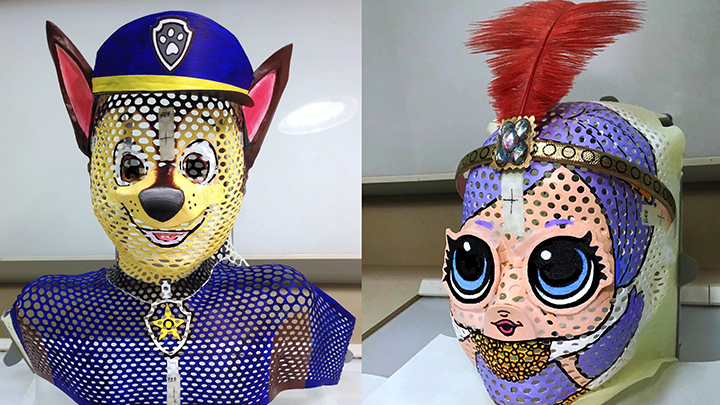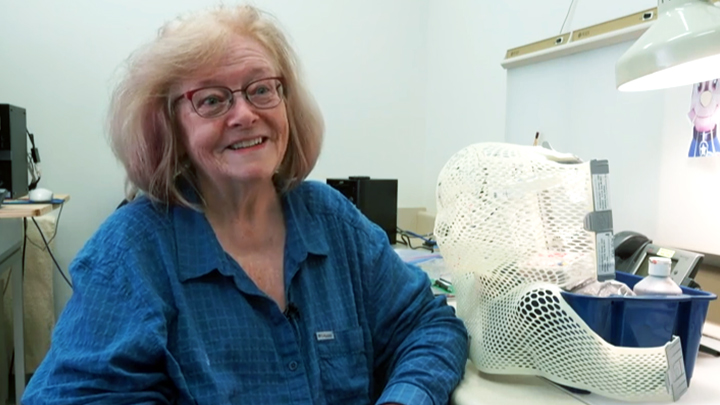
April 20, 2021

Alberta Health Services volunteer Marilyn Kimura paints fun faces onto the masks children wear while receiving radiation therapy. These two depict Chase from Paw Patrol and an LOL Doll.

To date, volunteer Marilyn Kimura has decorated 22 masks with the faces of popular superheroes, Disney movie or cartoon characters for pediatric patients at the Cross Cancer Institute in Edmonton.
Story by Alison Eresman | Photo by Marilyn Kimura
Children receiving radiation therapy are finding it easier to put on a brave face thanks to Alberta Health Services volunteers like Marilyn Kimura, who’s been painting colorful characters onto masks for pediatric oncology patients at the Cross Cancer Institute (CCI) for more than two-and-a-half years.
“When children need radiation therapy for head or neck cancer, a thermoplastic shell is custom-made to fit their head, neck and/or shoulders,” she says. “It’s rigid, beige and not at all friendly-looking. To make it more attractive to the children, I paint it with whatever image they want, such as their favourite superhero or Disney movie or cartoon character.”
The shells that Kimura paints ‘faces’ onto are known as pediatric immobilization masks. The masks are moulded specifically to fit the head and upper-body of a child and are intended to keep the child still and properly positioned while receiving radiation therapy. But they can be frightening to young patients facing the uncertainty of cancer treatment.
“The trick for me is to take this rather forbidding, uncomfortable, threatening, skull-like oddity and change it to something they would almost wear on Halloween,” adds Kimura. “It apparently makes them feel a little braver — and a bit more invincible — when they’re going through an otherwise very scary experience.”
The program started back in 2018, when CCI staff reached out to volunteer resources for support. Radiation staff had heard of similar programs at other hospitals and wanted something similar for their Edmonton patients.
“CCI staff had done some research on radiation oncology shells for children,” says volunteer resources coordinator Heather Dunn-Kinsman. “They found out that in big cancer facilities, not here in Canada, staff were painting shells. Some of the radiation therapists were the actual people painting shells, because they had art ability.”
Program staff at the CCI already had experience working with volunteers through other various programs —and knew that volunteer resources would be able to find people to generously paint the masks.
“They told me what they were looking at and asked if it was any kind of a possibility, and I said ‘of course it is!’” says Dunn-Kinsman.
She adds that the program supplies, including paints and brushes, are purchased with funding from the Cross Cancer Institute Volunteer Association.
Each mask is tailored to a child’s interests. While most pediatric cancer patients in Edmonton are treated at the Stollery Children’s Hospital, they are referred to the CCI to receive radiation therapy. A Stollery child life specialist and a CCI radiation therapist talk to the patient and parents to come up with an idea for the mask design. Their wishes are shared with Dunn-Kinsman, who relays the information to the artful Kimura.
“I’ve done Spider-Man, Batman, Superman, Iron Man, cats, dogs, unicorns, Peppa Pig, Elsa from the Disney movie Frozen, Edmonton Oilers helmets, a Minion and a Lamborghini” says Kimura. “It’s been a learning experience in children’s pop culture for me!”
According to Alison Naylor, a child life specialist at the Stollery, the masks have been well-received by both patients and parents.
“The masks have really done a lot to help kids get through those difficult treatments in a positive way,” says Naylor. “The parents also love the masks. Anything we can do to help make things more kid-friendly — and just a little less scary in the hospital environment — really helps the parents cope, which in turn, helps the kids cope.”
As a child life specialist, Naylor’s role is to help children understand what’s happening to them during their time in the hospital, and to help them feel as normal as possible while undergoing treatment.
“Any time we can make something fun for the kids, it takes the element of fear out and helps to make it a little bit easier for everyone,” says Naylor. “We’re really lucky to have such talented artists volunteer their time for this. We’re really grateful.”
The mask-painting program was one of the first to re-open when volunteer programs relaunched in June 2020. Due to the solitary nature of her volunteer role, Kimura notes that the ongoing pandemic hasn’t had much impact on her volunteer experience.
“I pick up the paint supplies at the volunteer office and then paint on my own until the shell is done. Often I attach things to make the shell more realistic looking, like ears and noses on animal masks, or the protective ‘cage’ on a goalie mask. One shell usually takes three or four days to complete.”
To date, Kimura has painted 22 masks.
“I feel so honoured to be able to do this. I believe that it is a good and important thing for the kids. And to be able to put whatever skills I have to good use is just such a privilege.”
Help us celebrate National Volunteer Week (April 18 to 24) by recognizing the amazing contributions of our volunteers. Share your appreciation through Sharing The Love or on Thanks For Caring.